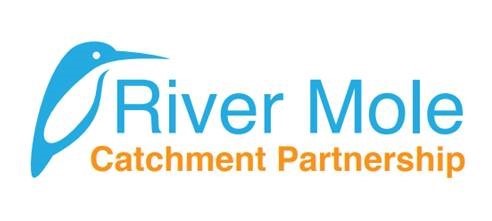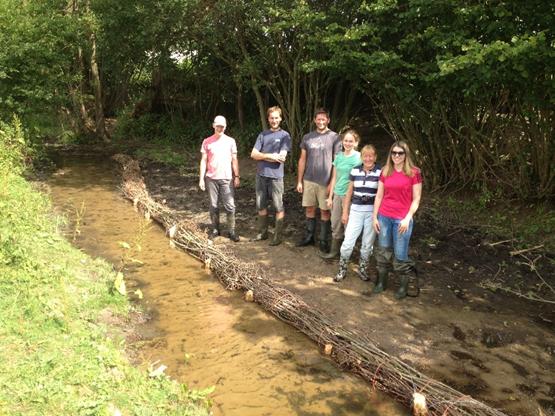River Mole Catchment Partnership
Catchment partnership vision
Our vision is for a healthy and diverse catchment where all interested sectors, groups or individuals can contribute effectively towards restoring the natural environment. Ensuring the sustainable use of its essential resources, whilst preserving other valued heritage assets, to benefit both people and wildlife today and in the future.

Related websites
Find out more about the activities and ambitions of this catchment partnership and how you can get involved to help improve the water environment in the catchment.
Catchment challenges
Current challenges identified by partnership

Pollution from waste water
Regular discharges across the catchment wide from sewage treatment works and storm water outfalls

Physical modifications
Highly fragmented catchment due to multiple barriers and impoundments which restrict fish passage and degrade habitat

Pollution from towns, cities and transport
Frequent pollution events are an ongoing issue in urban areas
Wider water environment challenges identified by partnership
Nature Recovery, designated areas for nature and biodiversity
The River corridor links multiple designated sites, improving the health of the river is critical to allow movement of species in the catchment
Reduce storm overflows and drainage system incidents
Habitat enhancements cannot achieve their maximum benefit as they are impacted by water quality issues, resulting from sewage and other pollutants
Support Nature Recovery Network and Local Nature Recovery Strategy
Working together to enable collective effort in nature’s recovery will be essential to achieving success in this area
Protect and restore healthy soils and nutrient balance
Healthy soils help to reduce flood peaks, maintain flows during dry weather, reduce diffuse pollution, improve biodiversity and sequester carbon
Build environmental resilience and adaptation to climate change
We are increasingly seeing dry headwaters and flash flooding, we want a catchment with resilience is built into the overall ecological system
Future challenges predicted by partnership

Pollution from waste water
Pressures from sewage treatment works and misconnections are high in the catchment, ultimately this determines the success of river health

Invasive Non-native Species
Invasive species have a significant impact, affecting natural processes, native species & recreational use of the river, with climate change more INNS will arrive

Physical modifications
Too many structures along the catchment hindering fish and Eel passage, also modified channels causing over silting and reduced habitat quality, complex land ownership arrangements
Future challenges predicted by Environment Agency
Future challenges in 2050
- Invasive Non-native Species
- Pollution from Towns Cities and Transport
- Pollution from waste water
Emerging challenges
- Changes to the Natural Flow and Water Levels
- Pollution from waste water
- Pollution from Agriculture and Rural Areas
Partnership success highlights 2016 to 2021
Our vision is for a healthy and diverse catchment where all interested sectors, groups or individuals can contribute effectively towards restoring the natural environment. Ensuring the sustainable use of its essential resources, whilst preserving other valued heritage assets, to benefit both people and wildlife today and in the future. Since 2016, 10 multi agency restoration projects have been carried out across 4 separate waterbodies to restore natural processes, increase instream habitat and promote natural flood management (NFM) over 2.6 km of river. This also helped to increase liaison between agencies and the voluntary sector. There has been awareness raising through walks, talks, events and practical task days every year for the past 6 years during an annual Rivers Week to coincide with world rivers day. 20 volunteers trained in River fly monitoring and 200 surveys carried out across 33 different sites leading to one major pollution incident being resolved 21 volunteer river monitors trained in the RiverSearch citizen science project which mapped and monitored 30km of the river. Multiple Invasive Non-native Species workshops and task days delivered across the catchment leading to near eradication in the Leatherhead area. Mass water samples taken across 2 water bodies to isolate issues.

Partnership development plans
We would like to see co-ordinated planning at a landscape scale integrating environmental priorities into land management decisions, developments, water company investment, capital investment schemes and projects. Creating opportunities to tackle multiple issues whilst creating public benefits and harnessing new investment streams. Partnership aims to increase membership to include more community groups and engage a large and diverse audience.
Partnership priority actions and measures for 2022 to 2027
Confident
Enhancement/no deterioration measures in 2020-2025 Water Industry National Environment Programme
- Reason for measure
- Control or manage point source discharges
- Delivery mechanism
- Confirmed water industry national environment programme 2020-2025
- Location
- Mole
Confident
Gatwick Stream
- Reason for measure
- Mitigate the impacts on ecology from physical modifications in modified waters
- Delivery mechanism
- Other local funding
- Location
- Tilgate Brook and Gatwick Stream at Crawley
Confident
Riverfly monitoring led by Surrey Wildlife Trust
- Reason for measure
- Control or manage point source discharges
- Delivery mechanism
- Voluntary initiatives
- Location
- Mole
Confident
Lower Mole Flood Alleviation Scheme
- Reason for measure
- Mitigate the impacts on ecology from physical modifications in modified waters
- Delivery mechanism
- EA Flood/coastal risk management programme
- Location
- Mole (Hersham to R. Thames conf at East Molesey)
Less certain
Rye2Good Phase 3: Restore natural processes and connectivity through mitigation measures and mitigate flooding and pollution through wetland creation
- Reason for measure
- Mitigate the impacts on ecology from physical modifications in modified waters
- Delivery mechanism
- WEIF Water Environment Improvement Fund
- Barriers to delivery
- Secure funding
- Location
- Rye Brook at Ashtead
Less certain
Pipp Brook Restoration Phase 2: Re-naturalise channel, improve fish passage, tackle point source issues, wetland creation, deliver NFM
- Reason for measure
- Mitigate the impacts on ecology from physical modifications in modified waters
- Delivery mechanism
- WEIF Water Environment Improvement Fund
- Barriers to delivery
- Secure funding
- Location
- Pipp Brook
Less certain
Redhill Brook Restoration – Re-naturalise channel, improve fish passage
- Reason for measure
- Mitigate the impacts on ecology from physical modifications in modified waters
- Delivery mechanism
- None identified
- Barriers to delivery
- Secure funding
- Location
- Mole Upper Trib
Catchment Partnership contributors
Partners involved in the creation of this page and the actions of the partnership: